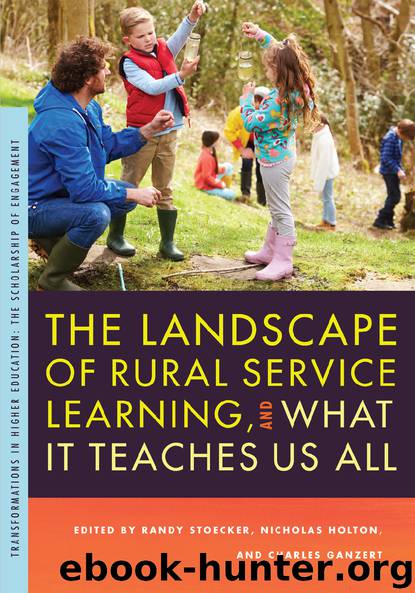The Landscape of Rural Service Learning, and What It Teaches Us All by Unknown

Author:Unknown
Language: eng
Format: epub
ISBN: 9781628962789
Publisher: Michigan State University Press
As the students begin to add flesh to their logic-model skeletons, we challenge one another’s ideas in class, and brainstorm ways to best approach each project so that we are pursuing what we would consider our greatest chance of success. We consult with our community partners, read journal articles related to each project, and consider laws and policies that may impact us, and we even beta-test some of the ideas in class or ask the Native Studies faculty to help us out personally or with their classes. All of these things help us determine needed resources, create backup plans, and adjust as necessary in a low-stakes environment before we get out into the real world.
As our relationships with all things in life continue to mature, we find that we grow into the leadership generation, the middle age, or the ingaagbiaagnang (western direction). The course progresses to the west. Each project progresses to the west. This article progresses to the west.
This is where the students begin implementing their plans. It is both an exciting and scary time for them. They want to see what is going to happen, but they are concerned about things not going as planned. It often takes a lot of reassurance from me to calm their nerves. I explain that in Anishinaabe culture, this is the generation that is expected to care for those who cannot always care for themselves. For some of the younger students who have not had much responsibility in their lives previous to this class, it can be quite a revealing process.
I remind the students that they are more than servants; they are students who are also expected to accomplish certain learning objectives as they go about doing what they have promised the community partners they would do. In particular, I expect the students to think on their feet, and to not lose their heads in the heat of the moment when they are under pressure to get things done. I expect them to have great fidelity to their plans, and if they have to deviate from those plans, they need to have good reasons and be accountable for such changes.
If they have to improvise, I want to know why, and I want to know how they overcame the obstacle. I want to know what happened, and that requires them to keep track of what is going on, using various data collection methods. Questions that help the students gather data from the implementation phase include: What were the activities that were actually included in the project? Who were the actual participants? Were there any surprises or unintended consequences?
As we enter into the giiwadinang (northern direction), it is a time for reflection. A time when we as Elders—older, wiser beings—look back on our lives and share lessons learned with younger generations as we help prepare them for future leadership roles. The course travels north. Each project travels north. This article travels north and ends with a conclusion that sums up the life of the article.
Download
This site does not store any files on its server. We only index and link to content provided by other sites. Please contact the content providers to delete copyright contents if any and email us, we'll remove relevant links or contents immediately.
The Motivation Myth by Jeff Haden(4528)
Audition by Ryu Murakami(4099)
Adulting by Kelly Williams Brown(3671)
The Confidence Code by Katty Kay(3566)
Waiting in the Wings by Melissa Brayden(2805)
A Mind For Numbers: How to Excel at Math and Science (Even If You Flunked Algebra) by Barbara Oakley(2691)
Self-Esteem by Matthew McKay & Patrick Fanning(2603)
Nice Girls Don't Get the Corner Office by Lois P. Frankel(2594)
The ONE Thing by Gary Keller(2519)
The Dictionary of Body Language by Joe Navarro(2430)
Fooled by Randomness: The Hidden Role of Chance in Life and in the Markets by Nassim Nicholas Taleb(2413)
How to be More Interesting by Edward De Bono(2356)
Getting Things Done by David Allen(2319)
Designing Your Life by Bill Burnett(2265)
The Plant Paradox by Dr. Steven R. Gundry M.D(2040)
Police Exams Prep 2018-2019 by Kaplan Test Prep(2033)
What Color Is Your Parachute? 2015 by Richard N. Bolles(1929)
Dangerous Personalities by Joe Navarro(1894)
When to Jump by Mike Lewis(1807)
